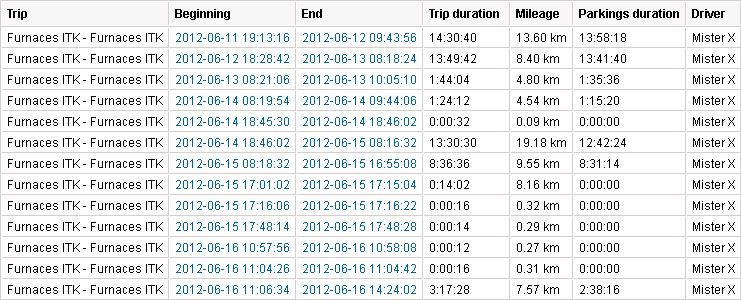See the Trips between geofences topic to learn how to prepare trips for this report.
A trip is considered to be unfinished when the unit leaves the starting point, and then, not having visited any of the final points, again appears in the point marked as the beginning. It can be the same zone from where the unit left (if circle trips are not allowed) or some other geofence with a starting point mark.
The available columns are described below.
| Column | Description |
|---|---|
| Trip | The departure and destination point. |
| Trip from | The departure point. |
| Trip to | The destination point. |
| Beginning | The date and time when the trip began. |
| End | The date and time when the trip ended. |
| Mileage | The distance travelled during the trip. |
| Mileage (adjusted) | The mileage subject to the coefficient set in the unit properties on the Advanced tab. |
| Trip duration | The amount of time it took to perform the trip. |
| Total time | The time from the beginning to the end of trip. It is recommended to use this column in combination with the grouping parameter or the Total row. If the Total row is configured in the table, it shows all the time that elapsed from the start of the first trip to the end of the last one. |
| Parkings duration | The time spent on parkings. |
| Avg speed | The average speed calculated for the trip. |
| Max speed | The maximum speed registered during the trip. |
| Driver | The name of the driver (if identified). |
| Trailer | The name of the trailer (if it was assigned). |
| Counter | The counter sensor value. |
| Initial counter | The value of a counter at the moment of leaving a departure geofence. |
| Final counter | The value of the counter at the moment of entering a destination end. |
| Count | The number of trips (can be helpful either when grouping the table data by years/months/weeks/days/shifts or for the reports on unit groups). |
| Status | The unit status registered during the trip. It can be registered manually or automatically by means of a notification. If there are several registered statuses, the first of them is displayed. |
| Consumed | The volume of consumed fuel detected by any sort of fuel sensor. If several such sensors are available, their values sum up. |
| Consumed by ImpFCS/AbsFCS/InsFCS/FLS/math/math for FLS/rates | The volume of consumed fuel detected by a fuel sensor (such as impulse/absolute/instant fuel consumption sensor, fuel level sensor) or calculated by math or rates. More information on fuel in reports can be found here. |
| Avg consumption | The average fuel consumption by any sort of fuel sensor. If several such sensors are available, their values sum up. |
| Avg consumption by ImpFCS/AbsFCS/InsFCS/FLS/math/math for FLS/rates | The average fuel consumption during the trip detected by one of the methods mentioned above. |
| Initial fuel level | The fuel level at the beginning of the trip. |
| Final fuel level | The fuel level at the end of the trip. |
| Max fuel level | The maximum fuel level. |
| Min fuel level | The minimum fuel level. |
| Penalties | The penalties calculated for the adjusted Eco driving criteria. |
| Rank | The received penalty points converted into a grade using a 10-point scoring system. |
| Notes | An empty column for your custom comments. |
| Video | Files saved during the trip using the Video module. To watch them, click on the icon (the number of grouped files is indicated to the right of it, if several). If several grouped files are available, you can select the required one in the drop-down list in the upper-left corner. The column is available if the Video monitoring service is activated in the account properties. |
| Image | The images received from the unit. Viewing images in reports and the functions available while doing this are described here. |
See the Trips between geofences section to find out more information about the additional parameters for unfinished trips.
Questions and answers



